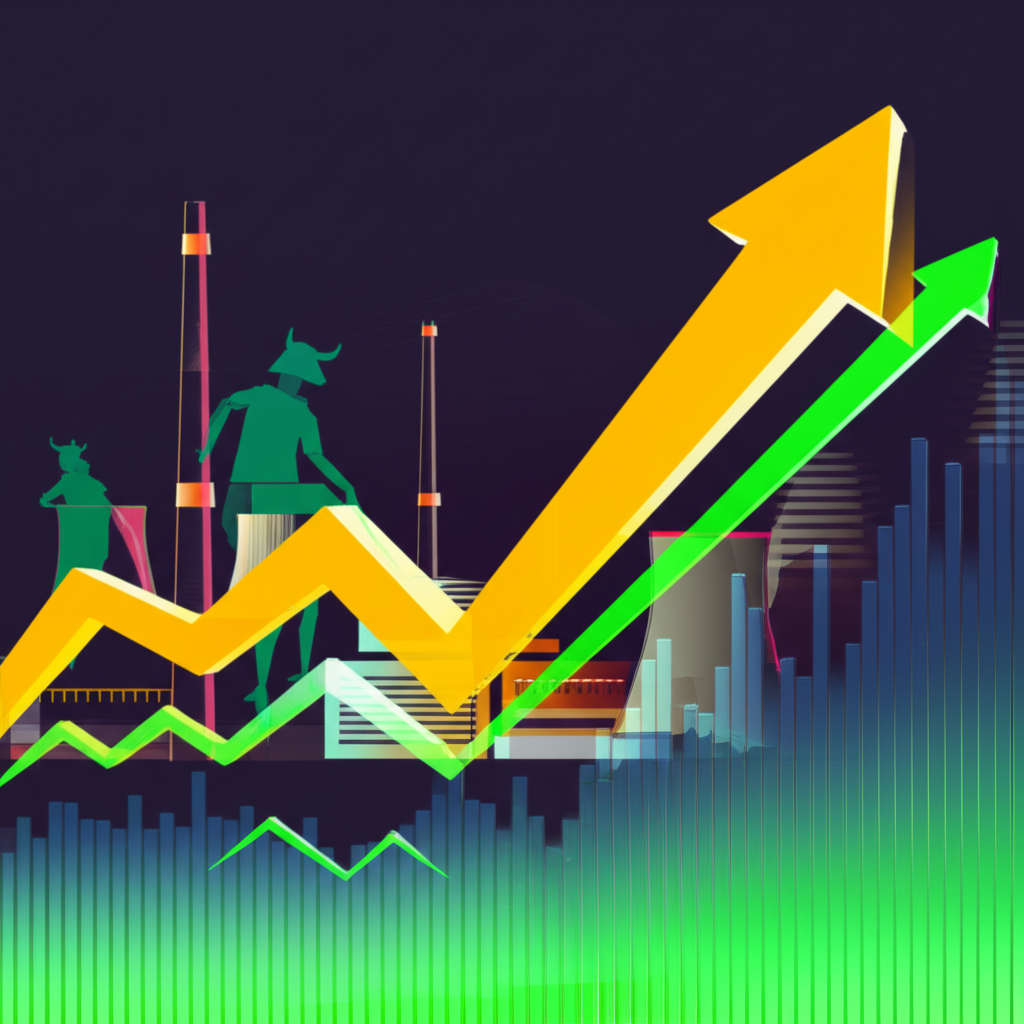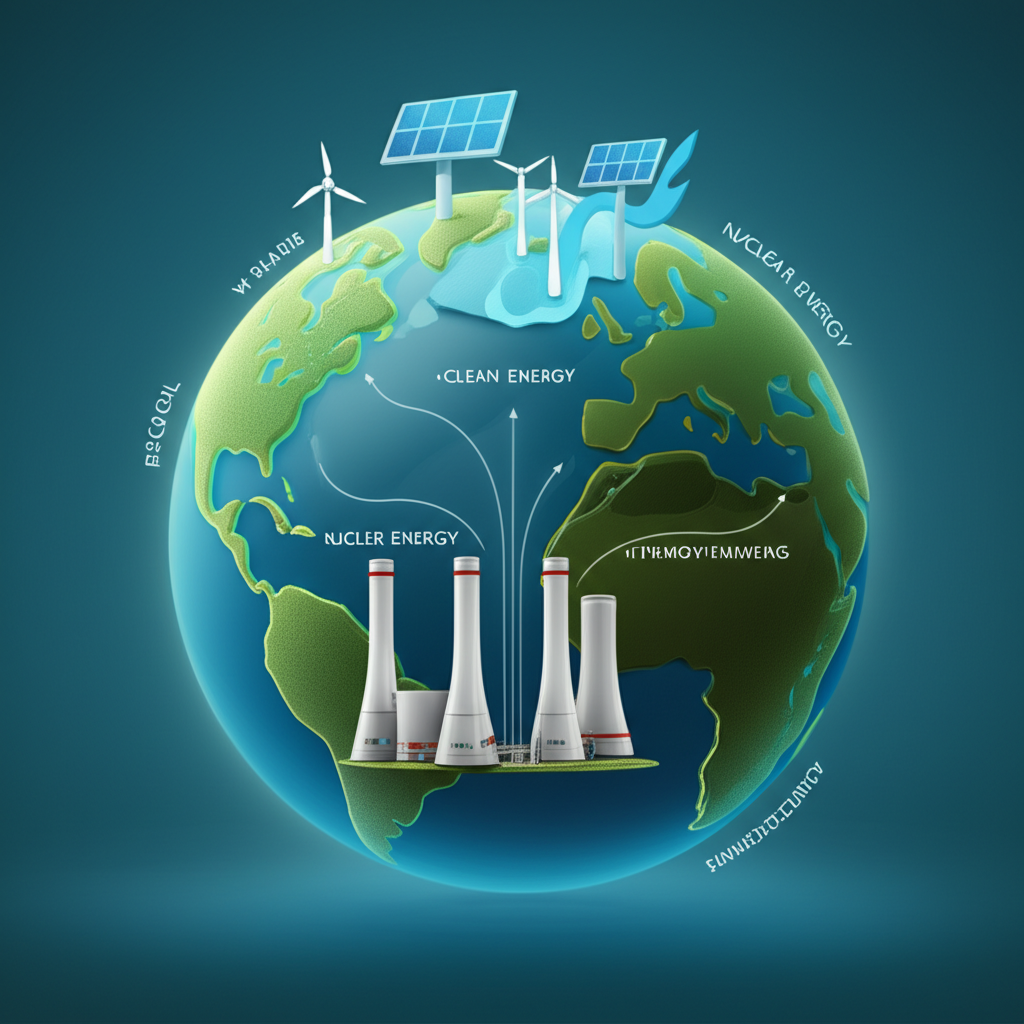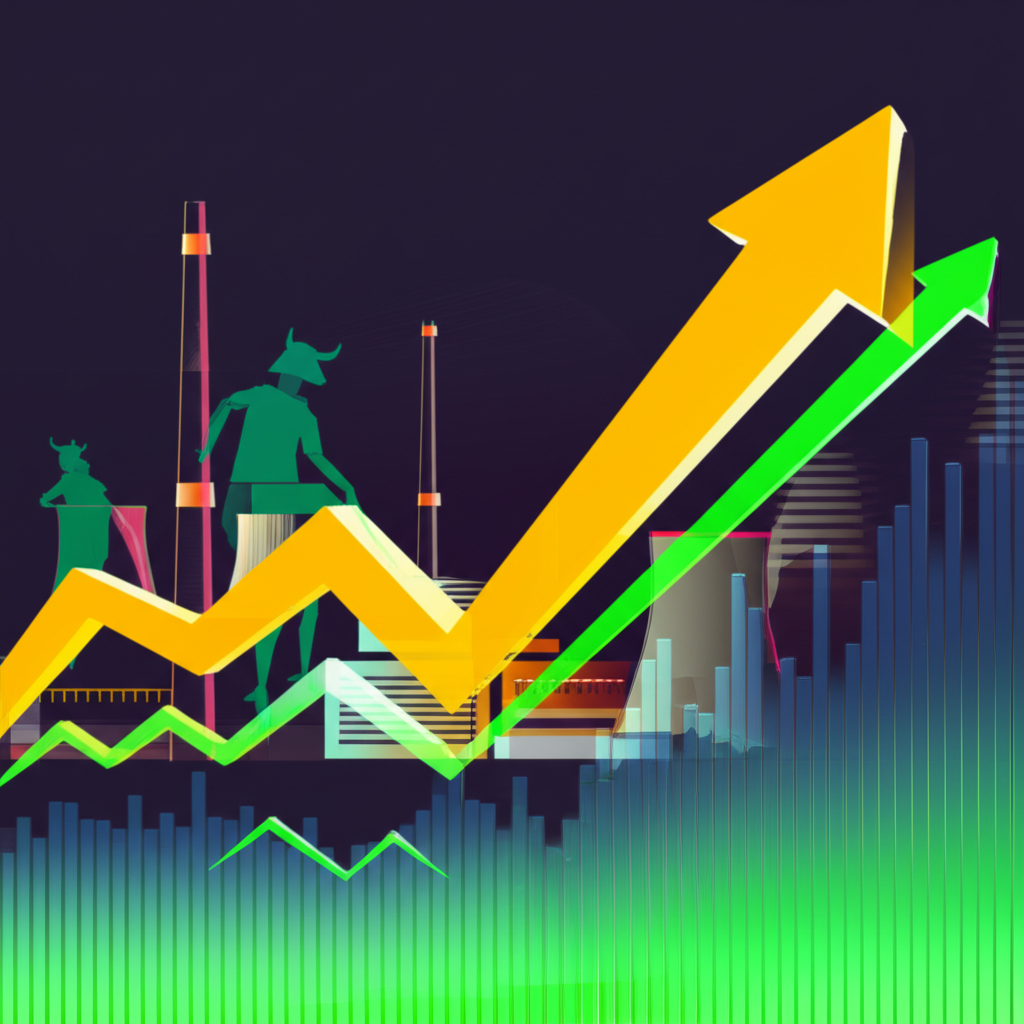Introduction: The Roaring Return of the Uranium Bull Market

The global energy system is in the midst of a seismic shift, and at its core is a powerful resurgence in nuclear power—one that’s reigniting investor interest and driving a compelling uranium bull market. After more than a decade of suppressed prices and minimal investment, uranium is no longer just a sidelined commodity. It has re-emerged as a critical component of the world’s clean energy and energy security strategies. This renewed momentum isn’t speculative noise; it’s rooted in structural forces reshaping how nations produce and secure electricity. From climate commitments to geopolitical instability, the factors fueling this upswing are both urgent and enduring. In this analysis, we unpack the forces behind uranium’s comeback, examine price projections through 2030, and outline strategic investment pathways for those seeking to navigate this evolving landscape. Understanding the dynamics of the current uranium bull market is essential for any investor positioning for the long-term transformation of global energy.
Understanding the Fundamentals: Why Uranium Is Surging

The surge in uranium prices reflects a fundamental rebalancing after years of market neglect. Unlike short-lived rallies driven by speculation, today’s price momentum is grounded in tangible shifts in supply, demand, and policy. The world is finally acknowledging what experts have long argued: nuclear energy is indispensable for a reliable, low-carbon grid. As a result, uranium—once dismissed as outdated or risky—is now being revalued as a strategic resource.
The Nuclear Energy Renaissance: A Global Imperative
A broad-based nuclear renaissance is underway, with governments across North America, Europe, and Asia recalibrating their energy policies. The International Energy Agency has made it clear: achieving net-zero emissions by 2050 is not feasible without a significant expansion of nuclear power. Unlike intermittent renewables, nuclear provides stable, baseload electricity that can operate 24/7, making it a cornerstone of energy reliability. Countries like France, the UK, Japan, and South Korea are extending the operating lives of existing reactors, while the United States and Canada are advancing new builds and supporting next-generation technologies. China is leading the charge with the most aggressive nuclear expansion program globally, planning dozens of new reactors over the next decade. A major catalyst in this shift is the advancement of Small Modular Reactors (SMRs), which promise to reduce construction timelines, lower upfront capital costs, and enable deployment in remote or smaller grids. These innovations are removing traditional barriers to nuclear adoption and accelerating the pace of global nuclear growth.
Deep-Rooted Supply Deficits and Production Constraints
While demand is rising, the supply side of the uranium market remains alarmingly fragile. For over a decade, persistently low prices discouraged investment in exploration and mine development. Major producers slashed capital expenditures, and new projects were shelved. The result? A shrinking global mining base unable to meet future demand. Uranium mines are inherently long-lead-time projects—discovery to production often takes 10 to 15 years. Today, many existing mines are nearing depletion, and operational disruptions are increasingly common. For example, Cameco’s Cigar Lake mine and Kazatomprom’s operations in Kazakhstan have faced repeated production shortfalls due to technical and regulatory challenges. These issues are compounded by geopolitical risks. Instability in key producing regions—such as Niger, where military coups have disrupted supply, or Russia, which dominates enrichment capacity—adds another layer of uncertainty. Sanctions and trade restrictions further constrain the global uranium supply chain, making it difficult for utilities to secure reliable fuel sources.
Accelerating Inventory Drawdowns and Market Rebalancing

The uranium market is undergoing a critical phase of rebalancing. For years, nuclear utilities relied on secondary sources—repurposed weapons material, excess stockpiles, and reprocessed fuel—to meet their needs. But those sources are now largely exhausted. As a result, utilities are returning to the primary market to secure long-term contracts, creating a surge in demand for newly mined uranium. This shift is happening just as financial players are entering the space. The Sprott Physical Uranium Trust (SPUT), launched in 2021, has become a pivotal force by purchasing and holding millions of pounds of physical uranium. By removing material from the spot market, SPUT effectively tightens supply and supports higher prices. Other institutional buyers and hedge funds are following suit, recognizing uranium not just as a commodity, but as a strategic store of value. This financial demand adds another layer of pressure on an already strained market, accelerating the pace of price discovery.
Key Drivers and Catalysts Fueling the Current Bull Run

Beyond the underlying supply-demand imbalance, several powerful catalysts are amplifying the current uranium bull market, transforming it into a sustained and potentially transformative cycle.
Geopolitical Dynamics and the Quest for Supply Chain Security
The war in Ukraine and broader geopolitical tensions have fundamentally altered how nations view energy security. Dependence on foreign energy sources—especially from adversarial or unstable regions—is now seen as a strategic vulnerability. This has prompted countries to diversify their uranium supply chains and reduce reliance on Russian enrichment services, which account for nearly half of global capacity. The U.S. and EU are actively funding domestic enrichment projects and forging new supply partnerships with allies like Canada and Australia. Japan and South Korea are also securing alternative sources. These efforts are not just about short-term stability—they reflect a long-term strategy to build resilient, geopolitically secure fuel cycles. As utilities scramble to lock in non-Russian supply, competition intensifies, pushing long-term contract prices higher and reinforcing the bullish sentiment in the market.
ESG Investing’s Shifting Perception of Nuclear Energy
One of the most consequential shifts in recent years is the evolving stance of ESG (Environmental, Social, and Governance) investors toward nuclear energy. Once excluded from many green investment portfolios due to concerns about waste and safety, nuclear power is now being recognized for its climate benefits. The European Union’s decision to include nuclear in its sustainable finance taxonomy was a watershed moment, signaling that nuclear qualifies as a green energy source under certain conditions. This regulatory endorsement has opened the floodgates for institutional capital. Pension funds, ESG-focused ETFs, and large asset managers are now allocating capital to nuclear projects and uranium equities. This shift isn’t just symbolic—it’s translating into real, sustained investment flows that are reshaping the sector’s financial landscape.
The Financialization of Uranium: Physical Trusts and ETFs
The emergence of financial vehicles has democratized access to uranium and fundamentally altered market dynamics. The Sprott Physical Uranium Trust (SPUT) has become a dominant player in the spot market, consistently purchasing uranium at or above market prices. This activity not only supports price levels but also creates a floor beneath which prices struggle to fall. Similarly, ETFs like the Global X Uranium ETF (URNM) provide investors with diversified exposure to a basket of uranium miners and physical trusts. These funds offer liquidity, transparency, and ease of access, making uranium investment viable for retail and institutional investors alike. The financialization of uranium has created a feedback loop: rising prices attract more investment, which tightens supply, which in turn supports further price gains. This mechanism is a key differentiator from past uranium cycles and suggests a more durable bull market.
Uranium Price Forecasts and the Market Outlook
Forecasting uranium prices requires a dual lens: understanding near-term supply tensions and long-term structural demand. The consensus among analysts and industry insiders is clear—prices are poised for significant upside, driven by a persistent deficit between supply and demand.
Short-Term vs. Long-Term Price Predictions (2025, 2030, and Beyond)
In the near term, uranium prices are expected to remain strong, with many analysts projecting continued gains through 2025. This optimism is fueled by robust utility contracting, ongoing financial buying, and limited new supply. The spot price, which hovered below $30 per pound for much of the 2010s, has rebounded sharply and could see further appreciation as the market tightens. Looking ahead to 2030, the outlook is even more bullish. Multiple research firms, including BMO Capital Markets and UxC, forecast prices reaching $100 per pound or higher. These projections are based on the anticipated growth in nuclear capacity, particularly in China, India, and Eastern Europe, as well as the time required to bring new mines online. The World Nuclear Association’s latest forecast envisions global nuclear generation more than doubling by 2040 under its high-case scenario, creating a sustained and growing demand for uranium.
Factors Influencing Future Price Movements and Volatility
Despite the positive trajectory, the uranium market is not without risks. New discoveries in Canada’s Athabasca Basin or Namibia could eventually boost supply, but development timelines remain long and capital-intensive. Technological advancements, such as high-assay low-enriched uranium (HALEU) for advanced reactors or potential breakthroughs in fuel recycling, may alter demand patterns in the long run. Economic downturns could temporarily reduce electricity consumption, affecting utility purchasing behavior. Perhaps most impactful are policy shifts—any reversal in nuclear-friendly regulations, such as Germany’s phaseout or future referendums in other countries, could dampen sentiment. However, the current momentum suggests that such setbacks would be isolated rather than systemic. The overarching trend—decarbonization, energy security, and technological innovation—remains firmly in uranium’s favor.
Navigating the Uranium Market: Strategic Investment Approaches
For investors, the uranium bull market presents a range of opportunities, each with distinct risk profiles and return potential. Choosing the right strategy depends on investment goals, risk tolerance, and market outlook.
Direct Exposure: Investing in Uranium Mining Stocks
Investing in individual uranium mining companies offers leveraged exposure to rising uranium prices. When the spot price increases, mining margins expand disproportionately, often leading to outsized gains in equity valuations. Established producers like Cameco and Kazatomprom offer relative stability, with diversified operations and long-term contracts. On the other end of the spectrum, junior explorers and development-stage companies—such as Uranium Energy Corp, NexGen Energy, or Paladin Energy—carry higher risk but offer substantial upside if they advance projects or make new discoveries. While these stocks can be volatile, they also provide exposure to operational growth and resource expansion, making them attractive for investors with a higher risk appetite.
Diversified Exposure: ETFs and Physical Uranium Trusts
For those seeking to minimize company-specific risk, diversified investment vehicles are ideal. ETFs like the Global X Uranium ETF (URNM) and the Horizons Global Uranium Index ETF (HURA) track baskets of uranium equities, spreading risk across multiple miners and geographies. These funds offer daily liquidity and are accessible through standard brokerage accounts. Alternatively, physical uranium trusts like the Sprott Physical Uranium Trust (SPUT) provide direct exposure to the commodity itself. SPUT holds actual uranium oxide (U3O8), stored in secure facilities, allowing investors to participate in price movements without dealing with mining risks or logistical complexities. These vehicles have become essential tools for both retail and institutional investors seeking pure-play uranium exposure.
Key Risks and Essential Considerations for Uranium Investors
While the fundamentals are strong, uranium investing is not without challenges. Commodity markets are inherently cyclical, and past cycles have shown that prolonged booms can be followed by sharp corrections. Regulatory changes, such as new environmental rules or export restrictions, can impact operations. Geopolitical risks—especially in key producing countries—can disrupt supply. Additionally, the long lead times for new supply mean that today’s deficits could eventually give way to oversupply, particularly if high prices incentivize a wave of new project approvals. Investors should approach the sector with a long-term perspective, conduct thorough due diligence, and consider dollar-cost averaging to mitigate volatility. Diversification—across company size, geography, and investment vehicle—can also help manage risk in this dynamic market.
Conclusion: The Enduring Appeal and Strategic Importance of Uranium
The current uranium bull market is not a fleeting rally but a reflection of deep, structural changes in the global energy system. Driven by the urgent need for clean, reliable power, energy security concerns, and a decade of underinvestment, uranium is being repositioned as a strategic asset. The nuclear renaissance, supported by policy shifts, technological innovation, and financial participation, is creating a durable tailwind for the sector. From SMRs to ESG integration, the forces at play are more robust and interconnected than in previous cycles. While risks exist, the long-term outlook for uranium demand and pricing remains strong. For investors, this presents a rare opportunity to participate in a commodity that is not only essential for decarbonization but also increasingly recognized as a cornerstone of national security and energy independence.
Frequently Asked Questions (FAQ)
1. What are the primary reasons behind the current uranium bull market and its sustainability?
The primary reasons include a global nuclear energy renaissance driven by climate goals and energy security, years of underinvestment leading to deep-rooted supply deficits, accelerating inventory drawdowns by utilities and financial entities, and growing acceptance of nuclear power within ESG investment frameworks. Its sustainability is supported by the long lead times for new uranium supply to come online and the increasing global commitment to decarbonization.
2. How does the global demand for nuclear energy specifically influence uranium prices?
Increased global demand for nuclear energy directly translates to higher demand for uranium, its primary fuel. As more reactors are built, existing ones have their lifespans extended, or new technologies like SMRs gain traction, utilities must secure long-term uranium supplies. This increased contracting activity and competition for available supply drive up the spot and long-term uranium price.
3. What are the most effective ways for different types of investors to gain exposure to the uranium market?
- For direct exposure: Invest in individual uranium mining stocks (majors like Cameco or speculative juniors).
- For diversified exposure: Use uranium-focused ETFs (e.g., URNM) or physical uranium trusts (e.g., Sprott Physical Uranium Trust – SPUT).
- These options cater to various risk appetites, from high-risk, high-reward individual stocks to more diversified, liquid fund structures.
4. What is the long-term outlook for uranium prices, specifically considering forecasts for 2025 and 2030?
The consensus among experts is for a continued upward trend. Many anticipate that uranium prices will go up in 2025 due to persistent supply deficits and increased contracting. The uranium price forecast 2030 is even more bullish, with many analysts predicting prices could reach triple digits per pound, driven by the expanding global nuclear fleet and continued supply-side constraints.
5. What are the key risks and challenges associated with investing in uranium or uranium-related stocks?
Key risks include market volatility, regulatory changes impacting mining or nuclear energy policy, geopolitical instability affecting supply chains, and the inherent cyclical nature of commodity markets. For individual mining stocks, company-specific risks like operational issues or project delays also apply.
6. How do geopolitical events and national energy policies impact the global uranium supply chain and market stability?
Geopolitical events (e.g., conflicts, trade disputes) can disrupt uranium production, transportation, and enrichment services, leading to supply shocks and price volatility. National energy policies, such as decisions to build new reactors, extend existing ones, or phase out nuclear power, directly influence long-term demand and market stability. The quest for energy security often drives nations to secure diverse uranium sources, impacting global trade flows.
7. What distinct roles do physical uranium trusts and ETFs play in the dynamics of the current market?
Physical uranium trusts (like SPUT) directly purchase and hold physical uranium, removing it from the spot market and converting it into a financial asset, thus tightening supply. ETFs (like URNM) offer diversified exposure to a basket of uranium companies, providing liquidity and making it easier for investors to gain broad market exposure without picking individual stocks, thereby channeling capital into the sector.
8. Are there any significant technological advancements in nuclear energy, such as SMRs, that could further impact future uranium demand?
Yes, Small Modular Reactors (SMRs) are a significant advancement. They offer benefits like lower capital costs, shorter construction times, and enhanced safety features, making nuclear power more accessible and deployable. Widespread adoption of SMRs is expected to significantly boost future uranium demand, contributing to the long-term uranium bull market outlook.
9. How does the current uranium bull market compare in characteristics and drivers to previous historical market cycles?
While previous cycles were often driven by specific events (e.g., reactor builds in the 70s, post-Fukushima dip), the current uranium bull market is characterized by a unique confluence of factors: a global climate imperative, geopolitical energy security concerns, and the innovative financialization of the commodity through trusts like SPUT. This suggests a more structurally underpinned and potentially prolonged bullish phase compared to past, more event-driven cycles.
10. What specific metrics or economic indicators should investors closely monitor to assess the health and direction of the uranium market?
Investors should monitor several key indicators:
- Uranium Spot and Long-Term Prices: Direct indication of market sentiment and supply/demand.
- Utility Contracting Activity: Signals future demand certainty.
- Uranium Production Figures: From major producers like Cameco and Kazatomprom.
- Global Reactor Construction & Operation: Number of reactors under construction, operational, or planned.
- Inventory Levels: Track drawdowns by utilities and financial entities.
- ESG Policy Shifts: Regarding nuclear energy’s classification.
- Geopolitical Developments: Especially in uranium-producing regions.

留言